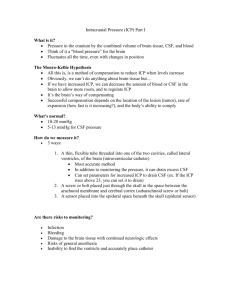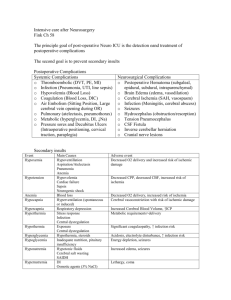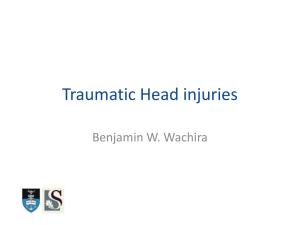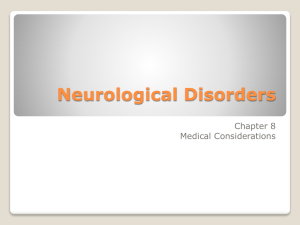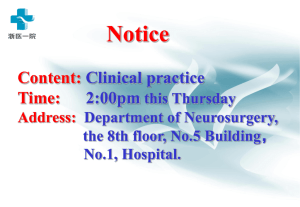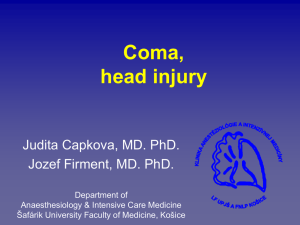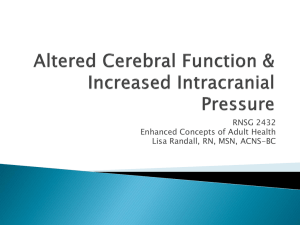Raised intracranial pressure
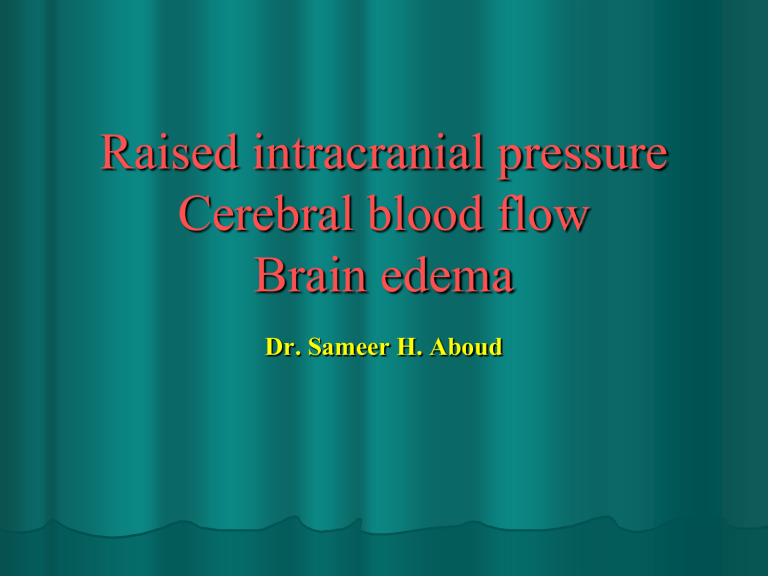
Raised intracranial pressure
Cerebral blood flow
Brain edema
Dr. Sameer H. Aboud
The Intracranial Cavity
The contents of the intracranial cavity
1: The brain about 1400 ml.
2: The blood 75-100 ml.
3: The CSF 75-100 ml.
All these three compartments are essentially
non compressible, and any change in the volume of the brain, causes a reciprocal change in the volume of one or both of the other two compartments. This is called the Monro-Kellie doctrine.
CSF
Obstruction to the flow of CSF at any point, results in dilatation of the venticular system proximal to the obstruction with profound effect on intracranial pressure.
Indications
for
Access
& contraindications
1. CSF analysis: Bacteriological, Immunological , Cytology,
2. Measuring CSF pressure in cases of pseudotumor cerebri, and normal pressure hydrocephalus.
3. The administration of antimicrobial and antineoplastic agents normally excluded by the BBB.
4. Therapeutic CSF drainage. in cases of CSF fistula, pseudotumor cerebri or communicating hydrocephalus.
Methods of access Contraindications
1. Lumbar puncture * Local inf.
2. Cisternal puncture. * ^ICP. Due to SOL
3. Ventricular puncture. * Blood dyscrasias.
Anticoaggualnt therapy .
C.B.F
BV= 75 ml
I.C.VP= ICP
CBF: 50ml/100gm/min
CPP=CrAP- VP(ICP)
CBF= CPP/ CVR
CrAP-(VP) ICP
CBF=--------------------
CVR
Cerebral Autoregulation
Brain Volume
An increase in brain volume is produced either by a:
S.O.L
Edema: increase in brain water.
1. Vasogenic edema : extra cellular, disturbance of BBB. localized around tumors, abscesses, hemorrhages and localized cerebral contusions. It may lead to herniation.
2. Cytotoxic edema : intracellular, hypoxia (cardiac arrest),
Intoxication, sever hypothermia. It is usually generalized.
3. Osmotic edema : ECF, Abnormal ADH sec. Sever hemodialysis, or excessive ingestion of water (Hysterical).
4. Hydrostatic Edema : ECF due to acute hypertension.
Elastance and Compliance
Compliance: Is that quality of distensibility available within the intracranial contents, which enable them to adapt to an expanding IC lesion.
Elastance: Is the resistance offered by the intracranial contents to the expansion of an intracranial mass. It is the inverse of compliance
Compliance is decreased by increased by:
1. Hypercarbia. Hypocarbia.
2. Hypoxia. Hyperoxia (PaO
2
3. Sleep. Hypothermia.
>1000 mm Hg)
4. Anesthesia. Barbiturates.
Intracranial pressure measurement
Normal I.C.P. this is 50-200 mm. water (10 mm Hg.) it is pulsatile owing mainly to I.C. arterial pulsation. It also shows fluctuations reflecting the respiratory and cardiac cycles.
Measurement
1.
L.P
: with the patient on his side, the L.P. needle is connected to a manometer. This method is not accurate, can not be used for monitoring and can be dangerous.
2. Ventricular cannulation : It is more accurate, can be used for long periods, but may be complicated by infection.
3. Subdural sensor { These are the safest and most reliable, and
4. Extradural sensor{ and are usually used for monitoring.
Effects of increased ICP
A: Effects on vital signs:
These appear to be due to compression and distortion of the brain stem. These effects are noticed in patients with critically raised intracranial pressure, and in experimental animals.
1. Decrease in respiratory rate.
2. Bradycardia.
3. Cardiac arrhythmias.
4. Pupillary constriction, followed by unilateral pupillary dilatation
5. Increase in pulse pressure.
6. Increase in arterial blood pressure.
Effects of increased ICP
B: Effect on cerebral blood flow:
CAP - JVP (ICP)
CBF = --------------------
CVR
When ICP increases, cerebral blood flow remains constant by auto regulation. the efficiency of this compensation depends on the rate of expansion of the lesion, it's nature and site. And also on the compliance of the intracranial contents.
CBF is increased in response to raised ICP, by cerebral vasodilatation , However this causes increase in cerebral blood volume and produces further brain swelling. When maximal vasodilatation occurs, further increase in ICP causes reduction in cerebral BF.
Effects of increased ICP
C: Clinical effects (symptoms and signs): Significant raised intracranial pressure can be present with out symptoms or signs.
1. Headache : Is typically maximal in the morning and is relieved by vomiting. It is caused by distortion, stretching or invasion of pain sensitive structures such as the bridging veins, basal and meningeal arteries.
2. Vomiting : Usually associates headache and typically occurs with out nausea.
3. Papilledema : This is the most reliable sign of raised ICP.
It's main features are:
Papilledema
Effects of increased ICP
D :Internal Brain herniation: resulting in strangulation, compression of vital structures and blood vessels.
1. Cingulate herniation : compress the internal cerebral vein and the anterior cerebral artery.
2. Central transtentorial herniation:
* Compression of the 3rd. nerve -------------> Dilated pupils .
* Compression of the post. cerebral art. ----> Hemianopia. Total blindness.
* Compression or ischemia of the brain stem.-> Decerebration. Coma.
* Distortion of the brain stem --------------> Hemorrhages.
3. Uncal herniation.
compression of the mid-brain, 3rd nerve and the post.
cerebral art.
4. Tonsilar herniation : Occurs when the cerebellar tonsils, herniate through the foramen magnum, resulting in compression of medulla, Decerebration, coma, cardiovascular and respiratory abnormalities (apnea).
Brain herniation
1.Cingulate herniation
2.Central transtentorial herniation
3.Uncal herniation
4.Tonsilar herniation
Medical Treatment of raised intra cranial pressure.
1. Sedation, and positioning:
2. Hypertonic solutions:
* Manitol: 0.5- 1gm/ Kg body wt. over 30 min. bolus injection.
* Furosemide: is effective in reducing brain edema, and reducing CSF production. 40-120 mg daily.
* Glycerol: can be given orally as well as I.V. 0.5-2 gm/ Kg. every 4 hrs.
3. Steroids: Dexamethasone 4mg four times a day.
4. Hyperventilation:
5. Hyperbaric oxygen: (rarely used).
6. Hypothermia:
7. Induced barbiturate coma: Has been used to reduce intracranial pressure in head injuries, and to increase brain tolerance to focal ischemia in aneurysm surgery , strokes and SAH.

